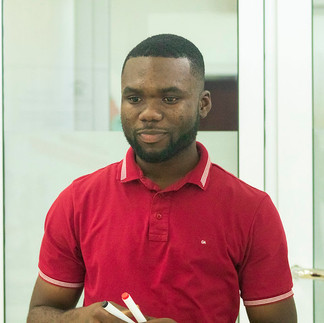D:LAB MOBILE DESIGN THINKING WORKSHOP (HYBRID EVENT)
- Ashesi D:Lab
- Jul 7, 2022
- 3 min read
The highly anticipated day, 7th July, finally came to be!. Ashesi Design Lab in partnership with Ashesi Entrepreneurship Centre organized a design thinking workshop to equip members running various projects with the skill set needed to develop effective solutions. There are currently, 14 projects that are running during this summer and also advancing slowly to the implementation phase. The teams are expected to develop their prototypes and carry out testing to gauge how users interact with their solutions. Paying key attention to this, the workshop was centered around teaching the teams how to design their solutions with a clear defined user in mind and with also incorporating the design thinking framework; empathize, define, ideate, prototyping and testing.
The hybrid event, which commenced at 3:30pm , saw 6 people in attendance physically and eight other members who attended online. The event which was held at the Entrepreneurship center, was conducted by Mr. Emmanuel Derry, who is in charge of ensuring that the teams are able to meet their objects. He explained that the purpose of the event was to help cement Design thinking as a tool in which the teams can adopt adequately in their respective projects to ensure that they are tailoring all their efforts towards satisfying the needs of a clear defined user.
Mr. Derry, took the participants through the general concepts of design thinking and then introduced them to the version commonly used at Ashesi University, which follows the following framework; research, analyze, ideate, prototype and testing. He used an analogy of two alumni from Ashesi University who fell in love with each other and ended up getting married to help the participants understand the design thinking process better. Furthermore, with this analogy, he showed how design thinking concepts can be integrated into our daily lives.
The link to the article that he used to elaborate more on the design thinking process is; https://outcomes.ashesi.edu.gh/finding-love-at-ashesi-ted-and-abena-111b8b08ff7a
Using the analogy;
Research
Looking at how Ted (from the story), saw Abena's profile online and searched through her social media for more information about her.
He explained the purpose of identifying the user first before commencing on any research. While carrying out the research, one needed to keep the user selected in mind and center the research around the user.
Analyze
Ted taking everything he has learned about Abena through her social media and meeting her in person/Him starting to form a mental image of who he thinks Abena is as a person.
He emphasized on the importance of looking through the research that has been collected and analyzing the problem that the user is experiencing. This can be done through frameworks such as creating a journey map, personas or empathy map to help you draw out the user's point of view(POV).
Ideate
Ted and Abena going on various types of dates trying to figure out which ones work for them and which ones did not.
With the POV( user's point of view), the researcher can now come up with solutions that help solve or address that particular problem. He explained how any ideas are welcome and no one should be critical of the ideas yet. The critique comes in after drawing all the ideas available so that one can determine which ideas are feasible.
Prototype
Ted and Abena starting a relationship with the final solution being marriage.
He emphasized the importance of coming up with a simpler model of the solution at first and then testing the prototype to determine its functionality.
He then went ahead to mention the importance of the final stage, which is testing. He elaborated how the testing phase was the most crucial part as it helped with identifying flaws with ones prototype and one can be able to gain valuable insights on the workability of the project.
After Mr. Derry explained the analogy, he went ahead to give the participants a challenge. The participants were required to take the challenge through the process of design thinking and be able to model a suitable solution to help address the problem. He mentioned the importance of identifying the user first before beginning with research on the challenge. The challenge was that it was difficult balancing curricular activities and extra-curricular activities. The participants were split into three groups, one group for all online members and two groups for the participants physically present for the session. After fifteen minutes dedicated for the challenge, the participants went ahead to present their solutions.
After the presentations from every team, the meeting was called to an end with Mr. Derry, reminding everyone to instill the design thinking process into their projects as that it is user-centered and a value engineered process.





























Comments